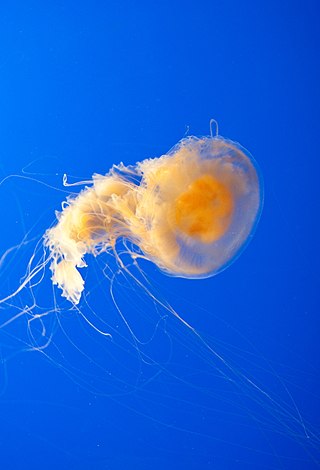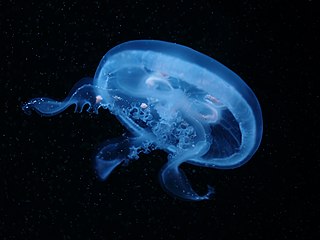
Aurelia aurita is a species of the genus Aurelia. All species in the genus are very similar, and it is difficult to identify Aurelia medusae without genetic sampling; most of what follows applies equally to all species of the genus. The most common method used to identify the species consists of selecting a jellyfish from a harbour using a device, usually a drinking glass and then photographing the subject. This means that they can be released in to the harbour shortly afterwards and return to their natural habitat.

Cassiopea is a genus of true jellyfish and the only members of the family Cassiopeidae. They are found in warmer coastal regions around the world, including shallow mangrove swamps, mudflats, canals, and turtle grass flats in Florida, and the Caribbean and Micronesia. The medusa usually lives upside-down on the bottom, which has earned them the common name. These jellyfish partake in a symbiotic relationship with photosynthetic dinoflagellates and therefore, must lie upside-down in areas with sufficient light penetration to fuel their energy source. Where found, there may be numerous individuals with varying shades of white, blue, green and brown.

Phacellophora camtschatica, commonly known as the fried egg jellyfish or egg-yolk jellyfish, is a very large jellyfish in the family Phacellophoridae. This species can be easily identified by the yellow coloration in the center of its body which closely resembles an egg yolk, hence how it got its common name. Some individuals can have a bell close to 60 cm (2 ft) in diameter, and most individuals have 16 clusters of up to a few dozen tentacles, each up to 6 m (20 ft) long. A smaller jellyfish, Cotylorhiza tuberculata, typically found in warmer water, particularly in the Mediterranean Sea, is also popularly called a fried egg jellyfish. Also, P. camtschatica is sometimes confused with the Lion's mane jellyfish.

Aurelia is a genus of scyphozoan jellyfish, commonly called moon jellies. There are currently 25 accepted species and many that are still not formally described.

Cassiopea andromeda is one of many cnidarian species called the upside-down jellyfish. It usually lives in intertidal sand or mudflats, shallow lagoons, and around mangroves. This jellyfish, often mistaken for a sea anemone, usually keeps its mouth facing upward. Its yellow-brown bell, which has white or pale streaks and spots, pulsates to run water through its arms for respiration and to gather food.
A species description is a formal scientific description of a newly encountered species, usually in the form of a scientific paper. Its purpose is to give a clear description of a new species of organism and explain how it differs from species that have been described previously or are related. To be considered valid, a species description must follow guidelines established over time. Naming requires adherence to respective codes, for example: in zoology, the International Code of Zoological Nomenclature (ICZN); plants, the International Code of Nomenclature for algae, fungi, and plants (ICN); viruses, the International Committee on Taxonomy of Viruses (ICTV). The species description often contains photographs or other illustrations of type material along with a note on where they are deposited. The publication in which the species is described gives the new species a formal scientific name. Some 1.9 million species have been identified and described, out of some 8.7 million that may actually exist. Millions more have become extinct throughout the existence of life on Earth.

Nausithoe aurea, also known as the Nausithoe maculata, is a species of crown jellyfish found off the southeastern coast of Brazil. The central disc has been measured to be 10.5 mm. N. aurea is transparent with yellow and brown spots located around the gonads. N. aurea can reproduce either asexually by strobilation or sexually. Either ephyrae or planuloids may be produced by strobilation; only ephyrae can produce the medusal form. Strobilation can be induced to occur when food is abundant. In polyps, a large availability of food leads to strobilation if it is not regulated. N. aurea species usually take more than 20 weeks to begin the differentiation and development of reproductive organs.

Aurelia labiata is a species of moon jellyfish. It is a cnidarian in the family Ulmaridae. It is typically larger than Aurelia aurita, with individuals document up to 45 cm (18 in). However, much of its size range overlaps with A. aurita, making size an imperfect diagnostic tool. Most Aurelia labiata have a 16-scalloped bell, meaning the bell indents inward at 16 points, a characteristic that also appears in other Aurelia species. Aurelia labiata occurs in the northeastern Pacific Ocean, from the northern coast of California, north to Canada and into Alaska.

Diadumene is a genus of sea anemones. It is the only genus in the monotypic family Diadumenidae.

The South American sea nettle is a species of jellyfish from the family Pelagiidae. It is found from the Pacific coast of Peru, south along Chile's coast to Tierra del Fuego, and north along the Atlantic coast of Argentina, with a few records from Uruguay. Despite its common name, it is not the only sea nettle in South America. For example, C. lactea is another type of sea nettle in this region. Historically, C. plocamia was often confused with C. hysoscella, a species now known to be restricted to the northeast Atlantic. C. plocamia is a large jellyfish, up to 1 m in bell diameter, although most mature individuals only are 25–40 cm (10–16 in).

Cassiopea ornata are one of many Cnidarian species called the upside-down jellyfish. This pelagic jellyfish primarily lives in tropical waters, off the coast of Australia in shallow lagoons and around mangrove trees. The name "upside-down jellyfish" comes from the fact that it appears to be upside-down in its natural state—resting on its bell. Its bell is a golden/brown color and the tentacles vary with different shades of yellow. While the sighting of this particular species is rare, it is usually mistaken for vegetation like the other species in genus Cassiopea.

Cephea cephea, also known as the crown jellyfish, or cauliflower jellyfish, is a species of jellyfish in the family Cepheidae. It occurs in the tropical waters of the western Indo-Pacific to Northern Australia. The species was first described by Peter Forsskål in 1775 and originally given the name Medusa cephea. It inhabits the pelagic zone of tropical and sub-tropical waters and is most commonly found in the Indo-West Pacific, eastern Atlantic and the Red Sea. Although this species is among the most venomous jellyfish, it is not harmful to humans and is eaten as a delicacy and used for medical purposes in China and Japan. The species can achieve a diameter of up to 60 cm.

Desmonema is a genus of jellyfish under the Cyaneidae family found in colder waters near the Antarctic region and off of the coast of Argentina. They have a bell diameter that can extend over 1 meter and wide tentacles that are grouped together in clusters. They share similar anatomical and physiological structures to the genus Cyanea. Their sophisticated structures like the thick tentacles, sensory systems, and gastrovascular system allow Desmonema to easily capture and extracellularly digest their prey. In recent years, Desmonema were reported to have a commensal relationship with fishes under the Trachurus genus and a parasitic relationship with specimens of the Hyperia genus. The genus name derives from the Ancient Greek desmós (δεσμός), meaning "bond", and nêma (νῆμᾰ), meaning "thread".
Aurelia coerulea or Asian moon jelly is a species of moon jelly in the genus Aurelia. This species is native to the seas off Japan, China, Korea, and California, as well as the Mediterranean and other temperate seas. and they can also be found in coastal areas of China, Korea, California, the Mediterranean and other temperate seas. It is particularly abundant in artificial habitats and sheltered regions. It has a very high reproductive rate which can cause blooming events. A.coerulea blooming causes problems such as impairing fisheries, clogging the nuclear power plants and disrupting the local zooplankton abundance. The chemical compounds the species secretes as a self-defense mechanism can be used for pharmaceutical purposes.

Aurelia marginalis is a species of the genus Aurelia. All species in the genus are very similar, and it is difficult to identify Aurelia medusae without genetic sampling.
Cyanea citrea is a species of true jellyfish in the family Cyaneidae. It has been found in waters off the coasts of Japan and Russia. The generic name, Cyanea, is derived from the Latin cyaneus, meaning "deep or dark blue in color". The specific epithet, citrea, is derived from the Latin citreus, meaning "citrus", likely in reference to the species' orange color.
Cyanea purpurea is a species of true jellyfish in the family Cyaneidae. It has been found off the coasts of Sakhalin and China. The generic name, Cyanea, is derived from the Latin cyaneus, meaning "deep or dark blue in color". The specific epithet, purpurea, is derived from the Latin purpureus, meaning "purple", in reference to its violet color.
Aurelia ayla is a species of true jellyfish in the family Ulmaridae. It is known via type specimens found in waters off the coast of Bonaire.
Aurelia cebimarensis is a species of true jellyfish in the family Ulmaridae. It is known via type specimens found in waters off the coast of Brazil.
Aurelia columbia is a species of true jellyfish in the family Ulmaridae. It is known via type specimens found in waters off the coasts of the Northwestern United States and British Columbia.











